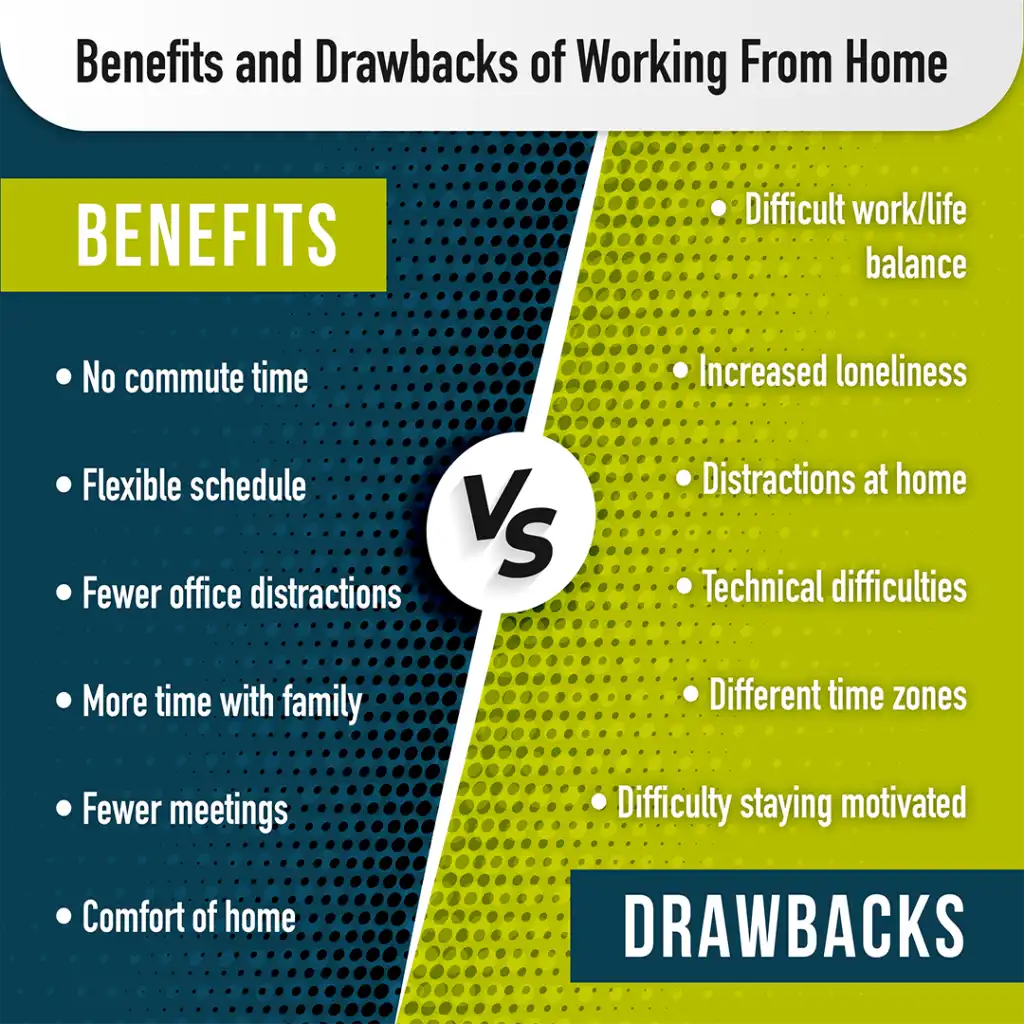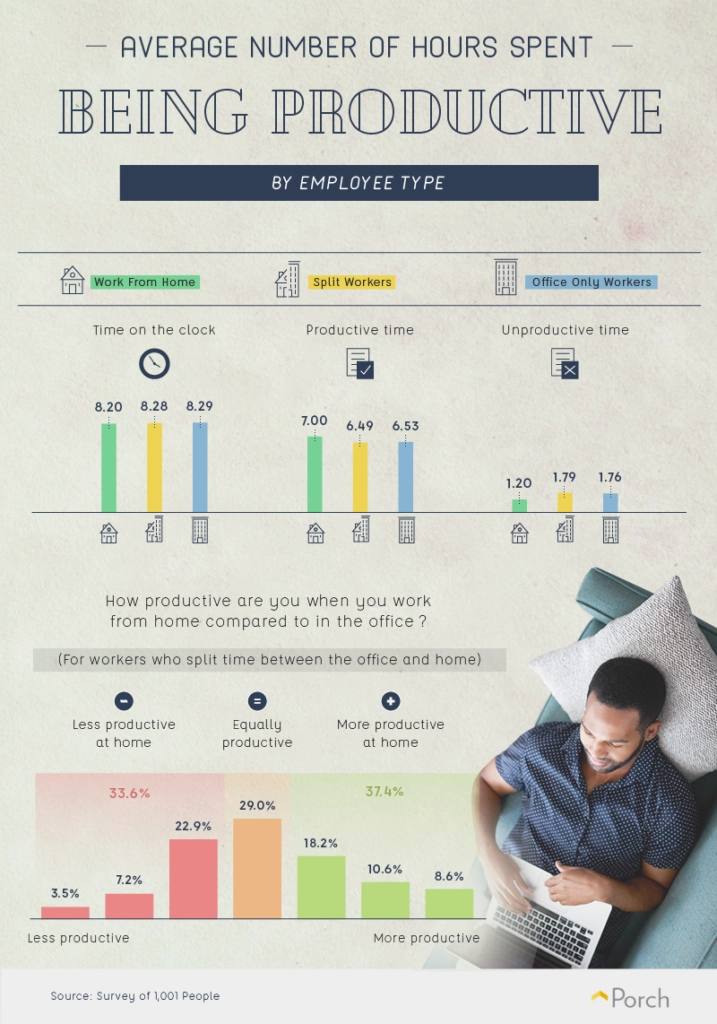The biggest pros and cons of working from home — Should you work from home?
Is your team working from home? Here’s some best practices to help motivate your team and help keep your project on track.
We have previously discussed current and future COVID-19 business trends. One of the most noticeable trends is working from home. Many offices have a fully or partially remote team. There can be many unique obstacles and opportunities. Find out what helps build a stronger and more unified team, even if they are working from home.
Why remote work is here to stay
Working from home is here to stay for a lot of businesses. Since the start of the COVID-19 pandemic, 42% of the US has been working from home.
Businesses have learned that working from home is possible. Employees have learned that they enjoy working from home and that their job can be done remotely.
Remote work brings new opportunities and benefits. So many companies are establishing and building out processes that will help employees succeed while working anywhere.
It’s 2020, and the world has changed. Many people have access to high-speed internet at home. There are new tools that allow teams to streamline their processes from anywhere.
Technology is advancing. Even credit card transactions have become seamless for remote workers. Some credit card terminals allow your teammates to accept customers’ credit cards online or over the phone. Employees do not have to be tied to a desk in order to work.
Experts expect remote work to quadruple in the near future. Before COVID-19, almost 5% of jobs were done remotely. Even after the pandemic, experts still expect 20% of jobs to stay remote.
Pros and Cons to having a work from home team
Some are excited about this new opportunity. Others are hesitant. It is new territory, and it comes with change. Working from home brings plenty of positives and negatives. However, the same could be said about working from an office.
Below, we compare the benefits and drawbacks of working remotely. These benefits and drawbacks affect individual employees. These same benefits and drawbacks also affect the company as a whole.

Benefits of working from home
Some employees actively like working from home. Companies have more to gain by allowing and encouraging remote work.
Employees have no commute time. This is a benefit to employees as it provides them with more time at home with their families.
This also benefits the company because there are fewer reasons employees would not be able to come to work. Employees will not be late to work because of a broken-down car or getting stuck in traffic.
This also reduces the amount of sick time a person may need. Your team will still need to take sick days. However, many times employees need to take a sick day because they do not feel well enough to leave the house. They may not want to leave out of concern of getting others sick. That does not always mean they do not want to work for the day. Sometimes a teammate might feel well enough to work from the comfort of their home. Working from home provides the flexibility they need.
The flexible schedule is beneficial for both parties. If employees need to run an errand or be home for services or repairs, they can be. They do not have to take off hours to be home for a window of time. Even if they have services being done on their house, they can continue to work at home during that time.
Employees can leave work for an hour or two if they have a family emergency. When they get home, their work will still be there. They do not have to run to the office to clock in or out for the day. They are not constrained by the hours the office doors are open or closed.
Working in an office can be distracting. Teammates might come up to ask questions or chitchat about their weekend. These sorts of conversations are helpful in building a community within your team. However, these conversations can also be distracting.
Today, if a teammate has a question, they can send an email. Their question will be answered, but the person they asked can respond on their own time. They are not having their train of thought cut by an email. They can easily finish what they are working on, and then help assist their teammate.
Along with less commute time, remote employees also have more time with their family. Working from home can provide more of a work/life balance. As soon as they are done with work for the day, they can log off, and immediately spend time with their family. They do not have to sit in a car in traffic for an hour. They might even be able to run errands during their lunch break that they would normally have to run at night. These changes are helpful in establishing a balance that allows for more free time for family or hobbies.
Working from home means that conversation needs to be shortened and more focused. Teams begin to consider what topics of communication are the most important.
A meeting is one way to hold a discussion. It is easy to schedule a meeting at the office when everyone is already there. Now that so many people are considering which conversations are important, they are doing the same for meetings. Companies are seeing a reduction in the number of weekly meetings.
Having fewer meetings is a good thing. Many people view meetings as a time waster. They can be distracting interruptions. By getting rid of unnecessary meetings, your team can focus more on the work they need to get done.
Working from home is comfortable. Employees can wear the clothing they want to wear. They do not have to be dressed up for the whole day. They have unlimited access to the refrigerator. With the touch of a button, they can control the lights and the temperature. No longer does your team have to settle on fluorescent lights and a freezing cold office.
Having a remote team can also help your company grow. No longer are you restricted to the candidate pool from your city. Now you can reach out and find the best candidates for your team. You might find experts in another state, or even another country.
You might not have been able to bring them on board before, but now you have the ability to do that. If you have a good employee that needs to go on an emergency trip, or even move across the country, you do not have to lose them. They can keep working with your organization.
There are so many positives to having your team work from home! Your team has more autonomy to their days, and more control over their lives. This can lead to happier teams, and a more positive work environment.
Drawbacks of working from home
Working remotely has its fair share of downsides as well.
With the increase in free time and accessibility to work, some people have issue finding a division between work and life. Everyone is different.
Some teammates will abuse working from home by multitasking too much. They may work on other things around the house, instead of focusing on work. They might work on laundry, cook food, or even watch TV. It can be tempting to focus too much on the “life” side of the balance.
Others will feel pressured to continue working, even late into the evening. They might not know how to turn off the “work” side of their brain. Working from home can lead to both overworking and underworking employees.
There is also a risk of increased loneliness. By nature, humans are social creatures. They thrive off of talking with others and spending time with their peers. If you have teammates stuck at home, with no form of daily interaction, they are likely to go a little stir crazy. Employees who thrive off being social may struggle with the loneliness. Be sure to check in on your teammates. Look for opportunities to increase their amount of interaction with others on the team.
Distractions exist anywhere you go. You may be able to weed out distractions like water cooler chat, but they are now replaced with home distractions. People may have pets or even kids they have to watch.
Within the last year, many parents have struggled with balancing work and home school. They may need to step away from the computer a few times a day to let the dog outside or help a child. Home distractions are different than work distractions.
No matter how much a person pays for Wi-Fi, there is always the chance that they will run into technical difficulties. They may have trouble with their computer or their printer. At the office, it is easier to fix those items. Normally, a person would just reach out to IT. IT could walk over and fix the issue. Now people have to problem solve their tech issues on their own.
Along with their computer, there’s also the chance their internet might be down for a whole day. It depends on their internet provider and their plan. Of course, these technical difficulties can decrease productivity.
Depending on where your team is working, they may be in different time zones. One person’s 8 AM – 5 PM schedule may look different than their coworker’s.
Having a teammate work from even one time zone away, can decrease the workday by 3 hours. Your full team might only be available for 5 hours out of the day. If a teammate is an hour behind, they will clock in later than everyone else, and they will take a different lunch break too.
Having schedules that are too different can make working with others difficult. They may have to consider when their teammates are available before sending emails.
Difficulty staying motivated is another concern. Some people are self-motivated, and they have no trouble staying focused throughout the day.
Others are motivated by their peers. They need the pressure of having someone look over their shoulder throughout the day. At home, there is no pressure like that. They may feel a drop in motivation. This could hurt their level of work, and negatively influence their sense of pride. People often feel stressed and frustrated when they feel unmotivated.
There are negatives to having your teamwork from home. Your team may feel less pressured to work. They may feel lonely and detached from others. They may worry that their hard work is unappreciated.
For some companies, there is some concern that working from home could lead to a decrease in security. As much as there are pros to working from home, there are also cons. You can do things to improve your team’s experience of working from home.
Best practices: How to help your remote team find success
There are many best practices when it comes to having a remote team. Although there are pros and cons to working from home, there are many solutions to the drawbacks that some people face. There are ways to improve team communication and uplift spirits. Some best practices include opening communication, fostering connections, making work accessible, and letting technology help.
There are several ways to open communication and foster connections across your team. Try baking the company culture into everything you do. Is helping others part of your company’s values? Encourage your team to be available to help their peers.
Part of the process starts through example. If you want your team to be helpful, you have to start the process. Actively reach out to your team to see if they need help. Be available when they do have questions.
Along with encouraging company culture, you will also want to help encourage team building. When people work in the office, they have the opportunity to have small talk. It can be distracting, and it can take a few minutes from their day, but it does help. Having those conversations help them build connections. Going to work is more fun when you know your coworkers and enjoy their company. Getting along with coworkers can determine if someone is content with work or not.
No longer do teammates have the opportunity to turn around and find out their desk mate shares the same hobbies. Since water cooler talk is fading out, it is up to you to encourage it.
Your team needs to unauthentically build relationships. Some companies encourage their employees to take a few minutes out of the day to play online games with colleagues. They might set aside time at the start of the day, or meetings, for everyone to catch up on life. Since those connections are not being made authentically now, you might have to schedule them.
Having weekly meetings is one way to help build relationships amongst your team. Video conferences allow the team to communicate face to face.
Communication is easier over video chat than over the phone. Video chats provide richer information than phone or email. Employees can see and hear inflections in their teammates’ voices. They can see others’ facial expressions. They may be focused on work, but it does provide socialization as well.
Having a meeting allows everyone to come together. They can share their ideas and thoughts. It allows them to regroup on projects. If they are working together on the same project, it creates a sense of camaraderie.
Consider ideas like virtual birthday parties. Many companies throw virtual birthday parties over Zoom or Teams. They will have the team sing Happy Birthday or share virtual cards. It is a few minutes of fun and celebration. Some companies will even send their employee flowers or cake.
Do not forget about other virtual meet ups like after-hour clubs, lunch break groups, or virtual happy hours. Have enough teammates with similar interests? Encourage them to start off-hour clubs. They might talk about similar hobbies, or even similar interests.
Remember that not everyone will have the same level of productivity at home, when compared to the office.

Image credit: Porch
Instead of focusing on the number of hours they work, consider focusing on productivity. If an employee only works for 7 hours one day, that does not mean they were not productive.
The opposite could be said as well. You might have an employee clock 10 hours in a day. What if they had trouble focusing the whole time?
Instead of focusing on timecards, try to focus on productivity instead. Focusing solely on a person’s timecard is the fastest way to kill motivation.
As a team leader, one of the best things you can do is learn how each of your teammates communicate. Everyone has different styles of communication and different preferences. You may feel like IM is more casual. Others may feel like IM is more pressing. Check in with your team to identify the best ways to communicate with them individually.
There may be other differences as well. Some people may work better off visual cues and may feel stressed not being able to see emotions. If you have a teammate struggling with this, consider including emojis in your IMs, texts, or emails. That might help them better understand what you are trying to say. It may make them feel more comfortable. You may need to adjust your communications towards each team member.
Working from home leaves us in a place where employees have more control over their daily life. That comes with real opportunities and concerns. Working from home brings a higher expectation of flexibility. Employees expect to be able to have a more flexible schedule. Teams need to be flexible in their communication, and their ways of working with others.
Having a part- or full-time remote team is the next step for many companies. Knowing how to improve the experience can make or break this new transition for your company. Company culture is changing for a lot of organizations. Now is the time to instill those expectations and best practices.
Acumen Connections is a locally owned and operated payment processor in Wichita, Kansas. Our organization seeks to help small businesses meet their goals with real solutions designed by real hardworking people. To help businesses and individuals achieve personal and professional successes, we’re providing new content weekly. Stay up on our posts by visiting the Acumen Connections Facebook, Instagram or Twitter pages, and visit the blog for a full catalog of resources fit for hardworking people.
Renee McBride


